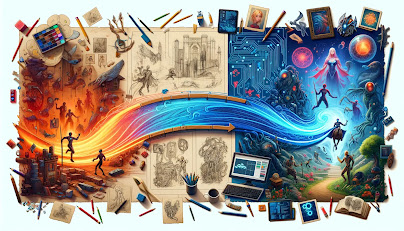In the dynamic world of game development, the integration of
Artificial Intelligence (AI) within the creation process has emerged
as a groundbreaking advancement, particularly in the realm of 2D
game art. This integration not only streamlines the development cycle
but also unlocks new horizons of creativity and innovation. As AI
continues to evolve, its role in game development, especially through
AI game development services, is becoming increasingly
indispensable, offering tools and solutions that significantly enhance
the visual appeal and engagement of games.
The Advent of AI in 2D Game Art
The journey of a game from its initial concept to the final product is
complex and multifaceted, involving various stages such as
conceptualization, design, implementation, and refinement. The
incorporation of AI within this pipeline, especially in the creation
and manipulation of 2D game art, represents a significant shift
towards more efficient and creative development processes. AI
can assist artists and developers at almost every stage, from
generating initial art concepts based on textual descriptions to
refining textures and animations to ensure they look just right.
Conceptualization and Design
The initial stages of game development are where ideas take shape,
and concepts begin to form the visual identity of the game. AI,
through machine learning algorithms and neural networks, can be
used to generate artistic concepts and elements based on broad
descriptions or even mood boards. This capability not only speeds
up the brainstorming process but also introduces a level of creativity
that might not have been previously considered. AI game development
services provide tools that can create multiple variations of character
designs, environments, and other key art assets, giving artists and
developers a wealth of ideas to work from.
Art Creation and Enhancement
Once the conceptual framework is in place, the next step involves the
creation of actual game assets. This is another area where AI
significantly impacts, particularly through automating repetitive tasks
and enhancing the overall quality of 2D game art. For example, AI
algorithms can automatically color line art, generate texture variations,
or even upscale lower-resolution assets without losing quality. These
capabilities not only reduce the workload on human artists but also
ensure a consistent art style across the game.
Animation and Implementation
Animation is a critical aspect of bringing game characters and
environments to life. AI can streamline the animation process,
particularly for complex sequences that would require significant
manual effort. Techniques such as inverse kinematics and automatic
rigging are enhanced by AI, making it easier to animate characters
and objects in a natural and fluid manner. Furthermore, AI can also
play a role in implementing these assets within the game environment,
optimizing them for performance and ensuring they interact correctly
with the game's physics engine.
Testing and Refinement
AI's role extends into the testing and refinement stages of game
development. AI-driven testing tools can identify visual bugs or
inconsistencies within the game art, suggesting refinements to
improve the final product. Additionally, AI can analyze player
feedback from test sessions to identify areas of the game that
might need visual enhancements or adjustments.
The Future of AI in 2D Game Art
The integration of AI in the 2D art pipeline is not just about automating
tasks or making the development process more efficient. It's about
opening new avenues for creativity and expression in game art.
As AI technology continues to evolve, we can expect even more
innovative tools and services that will further blur the lines between
AI-generated art and human creativity. AI game development services
are at the forefront of this revolution, offering a glimpse into the future
of game development where AI and human creativity work hand in
hand to create breathtaking game worlds.
Conclusion:
In conclusion, the integration of AI into the 2D game art pipeline
signifies a paradigm shift in how games are developed. From concept
to game, AI enhances every step, providing tools that empower
developers and artists to push the boundaries of their creativity. As
AI technology matures and becomes more accessible, the synergy
between AI and 2D game art will undoubtedly lead to the creation
of more immersive, visually stunning games that captivate and engage
players like never before.
Read more blogs about the gaming industry:
The Challenges and Solutions of Mobile Game Security
Case Studies: Successful Mobile Games and Their Marketing Strategies
Virtual Reality and Augmented Reality: The Next Frontier in Mobile Gaming

.jpg)

.jpg)
No comments:
Post a Comment